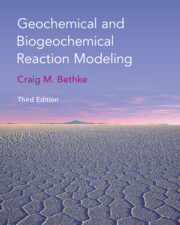Book contents
- Frontmatter
- Dedication
- Contents
- Preface
- Preface to Second Edition
- Preface to First Edition
- A Note About Software
- 1 Introduction
- 2 Modeling Overview
- PART I EQUILIBRIUM IN NATURAL WATERS
- PART II REACTION PROCESSES
- PART III APPLIED REACTION MODELING
- 26 Hydrothermal Fluids
- 27 Geothermometry
- 28 Evaporation
- 29 Sediment Diagenesis
- 30 Kinetics ofWater–Rock Interaction
- 31 Weathering
- 32 Oxidation and Reduction
- 33 Waste InjectionWells
- 34 Petroleum Reservoirs
- 35 Acid Drainage
- 36 Contamination and Remediation
- 37 Microbial Communities
- Appendix A Sources of Modeling Software
- Appendix B Evaluating the HMW Activity Model
- Appendix C Minerals in the LLNL Database
- Appendix D Nonlinear Rate Laws
- References
- Index
36 - Contamination and Remediation
from PART III - APPLIED REACTION MODELING
Published online by Cambridge University Press: 09 December 2021
- Frontmatter
- Dedication
- Contents
- Preface
- Preface to Second Edition
- Preface to First Edition
- A Note About Software
- 1 Introduction
- 2 Modeling Overview
- PART I EQUILIBRIUM IN NATURAL WATERS
- PART II REACTION PROCESSES
- PART III APPLIED REACTION MODELING
- 26 Hydrothermal Fluids
- 27 Geothermometry
- 28 Evaporation
- 29 Sediment Diagenesis
- 30 Kinetics ofWater–Rock Interaction
- 31 Weathering
- 32 Oxidation and Reduction
- 33 Waste InjectionWells
- 34 Petroleum Reservoirs
- 35 Acid Drainage
- 36 Contamination and Remediation
- 37 Microbial Communities
- Appendix A Sources of Modeling Software
- Appendix B Evaluating the HMW Activity Model
- Appendix C Minerals in the LLNL Database
- Appendix D Nonlinear Rate Laws
- References
- Index
Summary
We construct in this chapter reactive transport models of the mobility of heavy metals in an aquifer containing a complexing surface. The modeling shows that surface complexation can play a controlling role in the fate and transport of heavy metal contamination in the environment. Surface complexation causes not only retardation, as might be expected from simple sorption theory, but a pronounced tailing that hinders remediation by pump-and-treat methods.
Keywords
- Type
- Chapter
- Information
- Geochemical and Biogeochemical Reaction Modeling , pp. 431 - 438Publisher: Cambridge University PressPrint publication year: 2022

